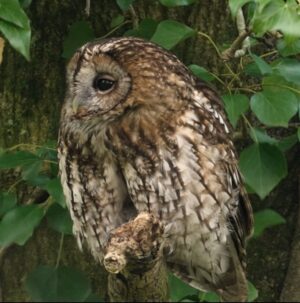Owls in woodlands; and a Woodlands TV film.

The tawny owl, sometimes called the brown owl, is found in woodlands across Europe. The barn owl is more likely to be found in open country such as farmland or grassland. Woodlands TV has recently produced a film abut encouraging owls in a woodland, interviewing Richard Lloyd Evans of Project Nestbox. The film "How to Encourage Owls to Your Woodland" can be seen below, or visit the Woodlands TV channel on You Tube..
Both owl species are birds of prey that hunt at night. They mainly hunt for rodents, though they are also known to prey on bats. Interestingly, some bats [like the greater mouse eared bat] when captured in a mist net, make a buzzing sound - reminiscent of bees and wasps. Researchers wondered if this was a defence mechanism - a form of batesian mimicry, where the prey animal resembles another species that is dangerous or distasteful in order to avoid being eaten. The research team recorded the buzzing sounds of different species of bee, wasp and hornet. They exposed these recordings to owls in a wild life rehabilitation centre. When the recordings were played the owls moved away from the speakers. So perhaps, bat buzzing startles an owl and makes the bat less likely to be eaten. In contrast, when the social calls of bats were played, the owls moved towards the sounds, perhaps thinking of a meal!.
When owls capture something like a vole, it is swallowed whole. Later, the indigestible parts (the bones and fur) are regurgitated as a pellet. Pellets may be found under trees used for roosting or nesting. When the pellets are opened up, they reveal very small bones but an intact skull may be found. Rodents are not the only prey, especially when the owls have young to feed. Young rabbits, small birds, earthworms and beetles may form part of the diet. Smaller and less powerful owls [for example, the little owl and the long-eared owl] generally cannot co-exist alongside the stronger / bigger tawny owls, indeed they may take them as prey.
The best time to see an owl is generally at dawn or dusk.
Curious fact : the owl has often been seen as an omen of bad luck : Shakespeare’s Julius Caesar.
"And yesterday the bird of night did sit
Even at noon-day upon the market-place
Hooting and shrieking.”
and
Japan has emerged as the largest importer of live owls globally, with these iconic birds becoming increasingly popular as pets and featuring prominently in animal cafés
Comments are closed for this post.
